Internet
This function page is only applicable when the mode is selected as "Both WAN/5G" and "WAN(Ethernet)".
More > Network > Internet
Log in to the device management page and go to More > Network > Internet to view relevant information.

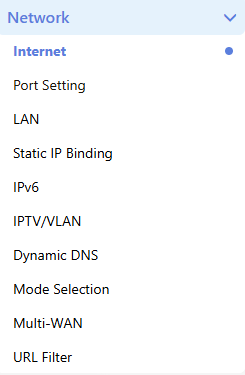
WAN Type
Please select the type of Internet connection provided by your Internet Service Provider (ISP).
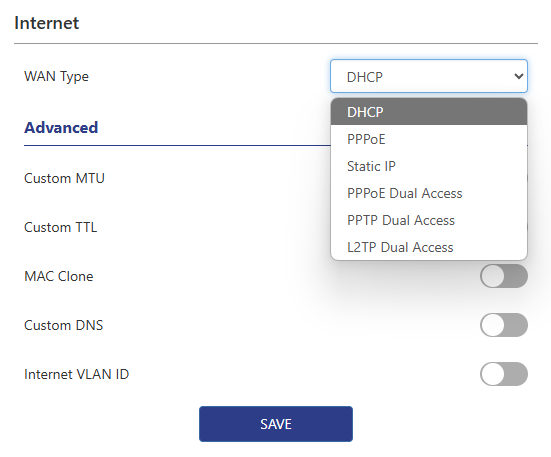
DHCP is a protocol that automatically assigns IP addresses. It can automatically assign IP addresses, subnet masks, default gateways and other information to computers. Used in small networks such as homes or offices, it can easily manage and assign IP addresses, reducing the trouble of manual configuration.
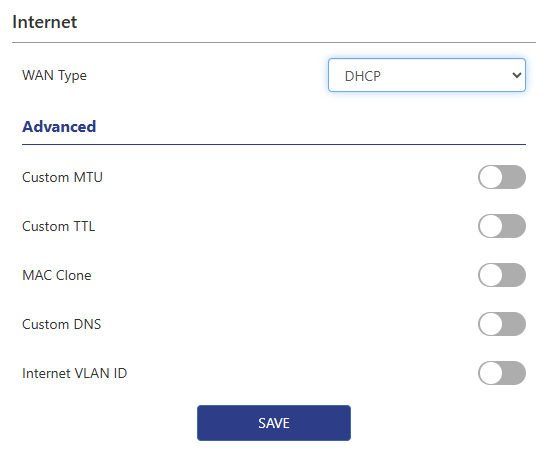
Advanced
- Custom MTU : Ethernet MTU (Maximum Transmission Unit), if your network provider requires you to adjust the MTU size, turn this option on, otherwise it is recommended that you turn it off for the best network experience.
- Custom TTL : TTL (Time To Live) is a setting that determines how long a data packet can exist in a network before it is discarded by a router. If your network requires a specific TTL value for better performance or security reasons, you can enable this option to set a custom TTL value.
- MAC Clone : If your network operator only allows one device to access the Internet, you can enable and bind the MAC address so that other devices connected to the router can also connect to the Internet.
- Custom DNS : If your network provider provides a fixed DNS address, you can enable this function and enter it. Otherwise, you do not need to enable it, as the router will automatically obtain it.
- Internet VLAN ID : The Internet ID is used to identify the characteristics of network data. For specific settings, please consult your network operator's customer service personnel or operation and maintenance personnel.
PPPoE is an authentication protocol used to establish secure connections on WANs, including functions such as verifying user identity and allocating IP addresses. Used for broadband access methods such as ADSL and optical fiber, which can provide secure network connection methods.
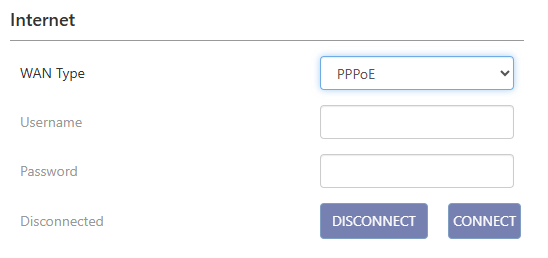
Advanced
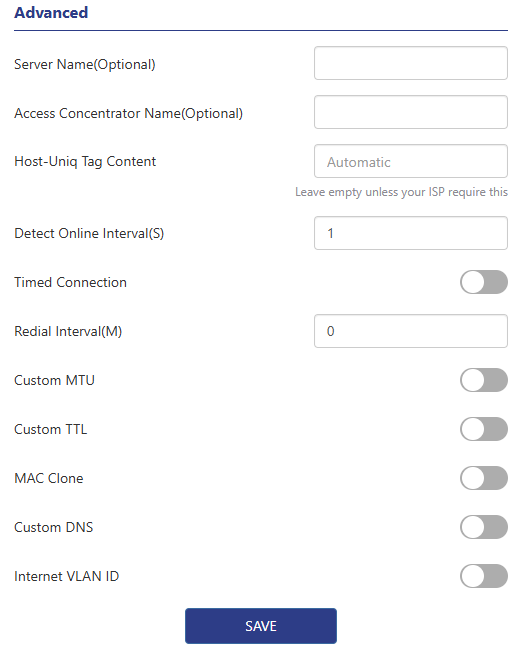
- Server Name : The Server Name is provided by your Internet Service Provider(ISP) and points to the name or address of the PPPoE server.
- Access Concentrator Name : The Access Concentrator Name, usually specified by the ISP, and is used to distinguish between different access points.
- Host-Uniq tag content : In the PPPoE (Point-to-Point Protocol Dial-Up) protocol, Host-Uniq is an optional field used to uniquely identify the host's request. Its main function is to ensure that when multiple users are connected through PPP in the same network, each connection request is unique to avoid confusion or conflict.
- Detect Online Interval : The Detect Online Interval is used to set the time interval for sending LCP Echo requests.LCP Echo requests are messages sent by the LCP component of the PPP protocol, which are used to verify that the link is still active and able to transmit data.An appropriate interval helps detect and address link problems in a timely manner.
- Timed connection : This option allows you to schedule the PPPoE connection to connect or disconnect at specific times. You can enable this feature and set the time for connection or disconnection.

- Redial Interval : If the PPPoE connection is lost, this setting determines how often the router will attempt to reconnect. You can specify the interval in seconds.
- Custom MTU : Ethernet MTU (Maximum Transmission Unit), if your network provider requires you to adjust the MTU size, turn this option on, otherwise it is recommended that you turn it off for the best network experience.
- Custom TTL : TTL (Time To Live) is a setting that determines how long a data packet can exist in a network before it is discarded by a router. If your network requires a specific TTL value for better performance or security reasons, you can enable this option to set a custom TTL value.
- MAC Clone : If your network operator only allows one device to access the Internet, you can enable and bind the MAC address so that other devices connected to the router can also connect to the Internet.
- Custom DNS : If your network provider provides a fixed DNS address, you can enable this function and enter it. Otherwise, you do not need to enable it, as the router will automatically obtain it.
- Internet VLAN ID : The Internet ID is used to identify the characteristics of network data. For specific settings, please consult your network operator's customer service personnel or operation and maintenance personnel.
Static IP refers to assigning a fixed IP address to the computer, as opposed to dynamic IP. Used for network connections, servers, remote access, etc. that require long-term stability to ensure the stability of the network connection.
Scenario 1: The parameters of IP address, subnet mask, gateway, and DNS server are provided by your operator. Fill in the parameters and click Save to complete the basic settings.
Scenario 2: Customize the IP address. Make sure to select an address within your LAN range that will not conflict with other devices. Fill in the IP address box, and after setting the correct subnet mask, gateway, and DNS server address, click Save to complete the settings.
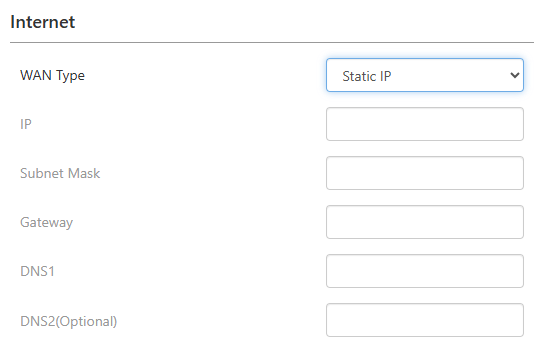
Advanced
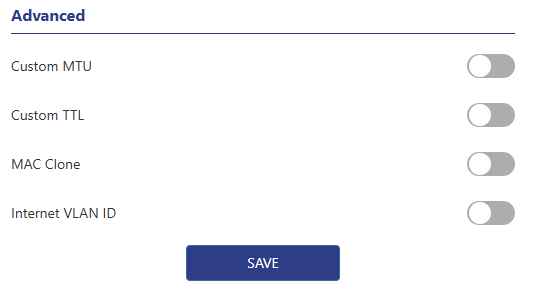
- Custom MTU : Ethernet MTU (Maximum Transmission Unit), if your network provider requires you to adjust the MTU size, turn this option on, otherwise it is recommended that you turn it off for the best network experience.
- Custom TTL : TTL (Time To Live) is a setting that determines how long a data packet can exist in a network before it is discarded by a router. If your network requires a specific TTL value for better performance or security reasons, you can enable this option to set a custom TTL value.
- MAC Clone : If your network operator only allows one device to access the Internet, you can enable and bind the MAC address so that other devices connected to the router can also connect to the Internet.
- Internet VLAN ID : The Internet ID is used to identify the characteristics of network data. For specific settings, please consult your network operator's customer service personnel or operation and maintenance personnel.
PPPoE dual access uses two PPPoE broadband lines at the same time to achieve balanced distribution of network traffic through load balancing technology. Used to improve network bandwidth and stability, suitable for occasions requiring large-traffic data transmission.
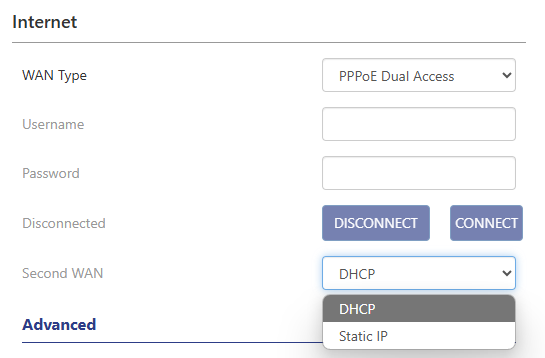
Advanced

- Server Name : The Server Name is provided by your Internet Service Provider(ISP) and points to the name or address of the PPPoE server.
- Access Concentrator Name : The Access Concentrator Name, usually specified by the ISP, and is used to distinguish between different access points.
- Host-Uniq tag content : In the PPPoE (Point-to-Point Protocol Dial-Up) protocol, Host-Uniq is an optional field used to uniquely identify the host's request. Its main function is to ensure that when multiple users are connected through PPP in the same network, each connection request is unique to avoid confusion or conflict.
- Detect Online Interval : The Detect Online Interval is used to set the time interval for sending LCP Echo requests.LCP Echo requests are messages sent by the LCP component of the PPP protocol, which are used to verify that the link is still active and able to transmit data.An appropriate interval helps detect and address link problems in a timely manner.
- Timed connection : This option allows you to schedule the PPPoE connection to connect or disconnect at specific times. You can enable this feature and set the time for connection or disconnection.

- Custom MTU : Ethernet MTU (Maximum Transmission Unit), if your network provider requires you to adjust the MTU size, turn this option on, otherwise it is recommended that you turn it off for the best network experience.
- Custom TTL : TTL (Time To Live) is a setting that determines how long a data packet can exist in a network before it is discarded by a router. If your network requires a specific TTL value for better performance or security reasons, you can enable this option to set a custom TTL value.
- MAC Clone : If your network operator only allows one device to access the Internet, you can enable and bind the MAC address so that other devices connected to the router can also connect to the Internet.
- Custom DNS : If your network provider provides a fixed DNS address, you can enable this function and enter it. Otherwise, you do not need to enable it, as the router will automatically obtain it.
- Internet VLAN ID : The Internet ID is used to identify the characteristics of network data. For specific settings, please consult your network operator's customer service personnel or operation and maintenance personnel.
PPTP Dual Access is a network connection method that uses two PPTP VPN connections to achieve dual network access. By using PPTP Dual Access, users can establish two PPTP VPN connections to access the Internet at the same time to improve bandwidth and network reliability.
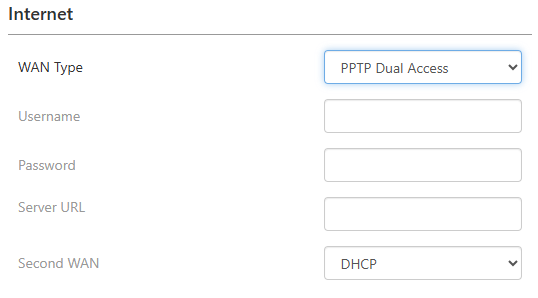
Advanced

- Custom MTU : Ethernet MTU (Maximum Transmission Unit), if your network provider requires you to adjust the MTU size, turn this option on, otherwise it is recommended that you turn it off for the best network experience.
- Custom TTL : TTL (Time To Live) is a setting that determines how long a data packet can exist in a network before it is discarded by a router. If your network requires a specific TTL value for better performance or security reasons, you can enable this option to set a custom TTL value.
- MAC Clone : If your network operator only allows one device to access the Internet, you can enable and bind the MAC address so that other devices connected to the router can also connect to the Internet.
- Custom DNS : If your network provider provides a fixed DNS address, you can enable this function and enter it. Otherwise, you do not need to enable it, as the router will automatically obtain it.
- Internet VLAN ID : The Internet ID is used to identify the characteristics of network data. For specific settings, please consult your network operator's customer service personnel or operation and maintenance personnel.
L2TP dual access is a network access method that uses two L2TP VPN connections. It allows users to access the Internet through two VPN connections, improving bandwidth and network reliability.

Advanced

- Custom MTU : Ethernet MTU (Maximum Transmission Unit), if your network provider requires you to adjust the MTU size, turn this option on, otherwise it is recommended that you turn it off for the best network experience.
- Custom TTL : TTL (Time To Live) is a setting that determines how long a data packet can exist in a network before it is discarded by a router. If your network requires a specific TTL value for better performance or security reasons, you can enable this option to set a custom TTL value.
- MAC Clone : If your network operator only allows one device to access the Internet, you can enable and bind the MAC address so that other devices connected to the router can also connect to the Internet.
- Custom DNS : If your network provider provides a fixed DNS address, you can enable this function and enter it. Otherwise, you do not need to enable it, as the router will automatically obtain it.
- Internet VLAN ID : The Internet ID is used to identify the characteristics of network data. For specific settings, please consult your network operator's customer service personnel or operation and maintenance personnel.